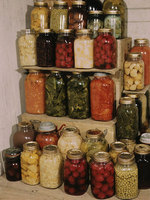 | Back to e-WV
| Back to e-WV
 The West Virginia Encyclopedia
The West Virginia Encyclopedia
 | Back to e-WV
| Back to e-WV
 The West Virginia Encyclopedia
The West Virginia Encyclopedia

People living in the area of present West Virginia have been preserving food since early times, and continue to do so today. Leather britches, sulphured apples, and smokehouse ham are among the traditional foods that have been preserved by West Virginians. In addition, frozen blueberries, canned green beans, and sauerkraut are popular.
Food preservation methods include salting, smoking, pickling, and drying, all popular among settlers during the 18th and 19th centuries and to some extent still in use today. Canning, packaging, and freezing are of more recent origins.
These techniques were used to preserve the abundance produced by summer gardens, fall hunting, and winter hog killing, in a day when people stocked their own larders. Hams were smoked or dry-cured in salt, and salt also was used to make brines for pickling. Cucumbers, cabbage, corn, and mixed green vegetables were pickled by placing them in a solution of salt, water, and seasonings. Left in this brine at room temperature, raw cabbage will bubble and foam for two or three weeks. When this stops, the chopped cabbage has become sauerkraut, and it is ready to be rinsed, canned, and served.
Various meats and fish were smoked with apple or hickory wood. The drying of meats, fruits, and vegetables was common. Two popular dried foods are dried green beans, also called shucky beans or leather britches, and sulphured or bleached apples. To make bleached apples, fresh apples are sliced and peeled, and then placed in barrels with the gases from burned sulfur. Sulfur preserves moisture and color, but on most farms apples were preserved by drying without sulfur, often simply by spreading sliced apples in the sun. The beans are strung on long strings and hung up to dry, perhaps in a stove corner or hot summer attic. Rehydrated by long, slow simmering in water with salt and a little pork fat, they made a savory dish indeed.
For over 100 years West Virginians have canned food, by sealing pickled or boiled foods in glass jars at home and occasionally in tin cans at a community canning plant. With canning it is not necessary to use quantities of salt and sugar, except for fruit jams, jellies, and preserves, where large amounts of sugar are used. Home canning was encouraged in the early 20th century by the homemakers extension service.
Corn and potatoes were important staples, preserved in different ways. Potatoes were simply dug, cleaned, and stored in a cool, dry, frost-free place, often an underground cellar. Sometimes potatoes were simply buried in the ground, as were cabbages. Corn was preserved in many ways, including as grits, hominy, cornmeal, distilled spirits, whole kernel sweet corn, and dry shelled corn. Ears of homegrown popcorn were kept as a special treat. These products and many others were stored in wood or metal bins, cloth bags, or sealed glass containers.
Prior to the electrification of West Virginia during the early and mid-20th century, few families relied on cold storage. Some used block ice and ice houses, but with the availability of electricity, freezing became widespread. Among the popular frozen foods in West Virginia were sweet corn, blueberries, beef and pork, and wild game.
Written by Mark F. Sohn
Robe-Terry, Anna Lee. Bootstraps and Biscuits: 300 Wonderful Wild Food Recipes from the Hills of West Virginia. Fairmont: A. L. Robe-Terry, 1997.
Sohn, Mark F. Mountain Country Cooking: A Gathering of the Best Recipes from the Smokies to the Blue Ridge. New York: St. Martin's Press, 1996.